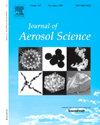利用摇滚乐模型,从重悬浮测量中优化重建附着力分布
IF 3.9
3区 环境科学与生态学
Q2 ENGINEERING, CHEMICAL
引用次数: 0
摘要
由于其对环境、工业和健康的影响,再悬浮这一被广泛研究了几十年的现象正在重新引起人们的兴趣,特别是对构成健康风险的可吸入颗粒(小于10 μm)。描述颗粒从表面再悬浮的模型通过使用它们的粘附分布作为输入来评估再悬浮颗粒的比例。然而,在微观尺度上测量附着力可能是一项具有挑战性和昂贵的任务,因为它需要特殊的技能和仪器,如原子力显微镜。在这项研究中,我们提出了一种反优化方法,从测量的再悬浮曲线估计附着力分布,作为一个优化过程。我们的算法利用广泛使用的摇滚乐(RnR)重悬浮模型,从黏附分布计算数值重悬浮曲线。通过均方根误差(RMSE)统计量,将计算的再悬浮曲线与测量的再悬浮曲线进行比较。优化过程旨在找到一条提供最小RMSE值的理论曲线。产生最佳拟合的参数决定了代表颗粒与表面相互作用的最佳粘附分布。我们使用Reeks和Hall(2001)的数据集来评估我们的算法,这使我们能够准确地评估他们所采用的粘附分布。然后,该算法用于估计我们为本研究进行的重悬测量的粘附分布。这些实验是在一个特殊设计的风管中进行的,其中8 μm直径的玻璃胶体从玻璃表面重悬。将该算法应用于我们测量的再悬浮曲线,得到附着力中值为~ 1400 nN的附着力分布。该值在玻璃胶体球与玻璃表面之间粘附的测量范围内。本文章由计算机程序翻译,如有差异,请以英文原文为准。
Optimized reconstruction of adhesion force distribution from resuspension measurements using the Rock’n’Roll model
Resuspension, a widely studied phenomenon for decades due to its environmental, industrial, and health impacts, is gaining renewed interest, especially for inhalable particles (smaller than 10 μm) posing health risks. Models describing particle resuspension from surfaces evaluate the fraction of resuspended particles by using their adhesion distribution as input. However, measuring adhesion in the microscale can be a challenging and expensive task, as it requires special skills and instrumentation, such as Atomic Force Microscopy. In this study, we suggest an inverse-by-optimization approach to estimate the adhesion distributions from a measured resuspension curve as an optimization process. Our algorithm utilizes the widely used Rock'n’Roll (RnR) resuspension model to calculate numerical resuspension curves from adhesion distributions. The calculated resuspension curves are compared to a measured resuspension curve based on their degree of agreement, as indicated by the Root Mean Squared Error (RMSE) statistic. The optimization process aims to find a theoretical curve that provides a minimal RMSE value. The parameters that yield the best fit determine the optimal adhesion distribution that represents the particles' interaction with the surface. We evaluated our algorithm using the dataset from Reeks and Hall (2001), which enabled us to accurately assess the adhesion distribution they had employed. Then the algorithm was used to estimate the adhesion distribution from resuspension measurements that we conducted for this study. These were performed in a specially designed wind duct where 8 μm diameter glass colloids of were resuspended from a glass surface. The application of this algorithm to our measured resuspension curves resulted in an adhesion distribution with a median adhesion force value of ∼1400 nN. This value lies within the range of reported measurements of adhesion between glass colloidal spheres and glass surface.
求助全文
通过发布文献求助,成功后即可免费获取论文全文。
去求助
来源期刊

Journal of Aerosol Science
环境科学-工程:化工
CiteScore
8.80
自引率
8.90%
发文量
127
审稿时长
35 days
期刊介绍:
Founded in 1970, the Journal of Aerosol Science considers itself the prime vehicle for the publication of original work as well as reviews related to fundamental and applied aerosol research, as well as aerosol instrumentation. Its content is directed at scientists working in engineering disciplines, as well as physics, chemistry, and environmental sciences.
The editors welcome submissions of papers describing recent experimental, numerical, and theoretical research related to the following topics:
1. Fundamental Aerosol Science.
2. Applied Aerosol Science.
3. Instrumentation & Measurement Methods.
 求助内容:
求助内容: 应助结果提醒方式:
应助结果提醒方式:


